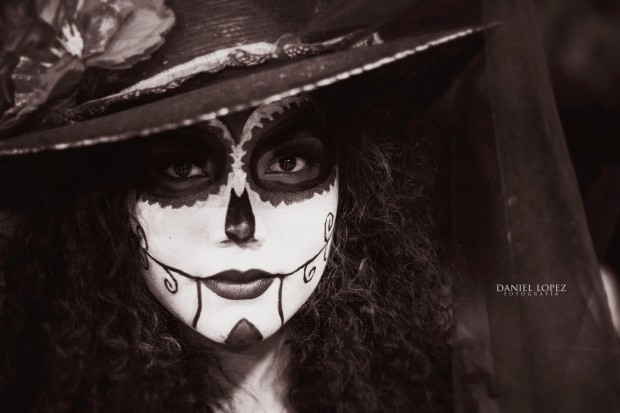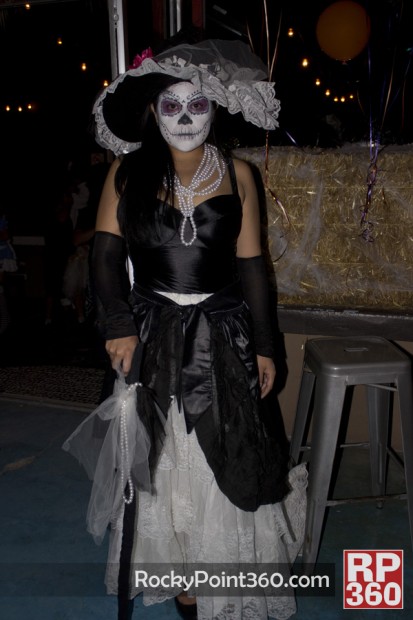
By MoKa Hammeken
“La Catrina” is a key element within Mexican culture. Originally she was created as a satire of Mexican aristocracy in the pre-revolutionary era. The original name of this celebrated figure, with 100% Mexican roots, was “Calavera Garbancera,” as “garbancera” was the nickname at that time given to people of indigenous ancestry who imitated and acted with European style and denied their cultural heritage.
The calavera does not wear any clothes, but only a hat; its creator describes it as, “…bones but with a French hat with its ostrich feathers.” What can be appreciated is a critique of many Mexicans who are poor, but still wish to appear with a European lifestyle that does not suit them.
Times were cruel. The social classes were extremely segmented and the highest class was the most fortunate and enjoyed many privileges; to the contrary, the lower classes were nearly invisible. To explain and rescue the folklore of worshiping the dead, while showing this off to high society, José Guadalupe Posada made caricatures of Death, one of these drawings being the famous calavera with an elegant hat, though only representing the head and bust with a sophisticated and skeletal essence.
 Time later, Diego Rivera rebaptized the calavera and gave it an entire body in the mural “Dream of a Sunday afternoon along Central Alameda.” Measuring 15 meters long, Rivera did this painting in 1948, in which the calavera appears accompanying José Guadalupe Posada, as the personification of the most well-known skeletal woman. It was at this point the muralist called the figure “Catrina,” a feminine version of the Catrín (which the Spanish Real Academy defines as well-dressed and honored), a “bon vivant” though as a woman. This name was subsequently popularized, making her a popular Mexican figure as the original meaning faded and she became a myth connecting with Nahua traditions of worshipping the dead and the underworld. As representation of Death itself, which is venerated on Nov. 1st and 2nd, Day of the Dead, a new tradition arises in which La Catrina visits all the cemeteries, one by one, sharing offerings and food with the dead and their families.
Time later, Diego Rivera rebaptized the calavera and gave it an entire body in the mural “Dream of a Sunday afternoon along Central Alameda.” Measuring 15 meters long, Rivera did this painting in 1948, in which the calavera appears accompanying José Guadalupe Posada, as the personification of the most well-known skeletal woman. It was at this point the muralist called the figure “Catrina,” a feminine version of the Catrín (which the Spanish Real Academy defines as well-dressed and honored), a “bon vivant” though as a woman. This name was subsequently popularized, making her a popular Mexican figure as the original meaning faded and she became a myth connecting with Nahua traditions of worshipping the dead and the underworld. As representation of Death itself, which is venerated on Nov. 1st and 2nd, Day of the Dead, a new tradition arises in which La Catrina visits all the cemeteries, one by one, sharing offerings and food with the dead and their families.
 Now Catrina is dressed in many ways and there are contests to find the most original and elegant representations, often with pure styles from the runway, all as part of the ecstasy and celebration of Day of the Dead.
Now Catrina is dressed in many ways and there are contests to find the most original and elegant representations, often with pure styles from the runway, all as part of the ecstasy and celebration of Day of the Dead.
To get a feel for this, I would like to recommend a Mexican short film that masterfully expresses this new form of viewing La Catrina, combining the new with the old. Hasta los Huesos, done by René Castillo in 2001, is about a man who dies and descends to the world of the dead, where a worm welcomes him with a bohemian festival and smiling skulls, and where Catrina herself sensually sings.
“La Catrina has become the referential image of Death in Mexico, it is common to see her embodied as part of the celebrations of Day of the Dead throughout the country; she has become a motive for the creation of handcrafts made from clay or other materials, her representations may vary, as well as the hat.” – J.G. Posada
La fina Catrina, la dama de México
Por MoKa Hammeken
 La llamada “Catrina” es un elemento clave en la cultura mexicana. Originalmente fue creada como una sátira a la aristocracia mexicana en la época prerrevolucionaria El nombre original de este celebre personaje 100 % de raíces mexicanas es “La Calavera Garbancera”, pues “garbancera” era el apodo que se le daba entonces a las personas de ascendencia indígena que imitaban y actuaban con las modas europeas, y renegaban de su herencia cultural.
La llamada “Catrina” es un elemento clave en la cultura mexicana. Originalmente fue creada como una sátira a la aristocracia mexicana en la época prerrevolucionaria El nombre original de este celebre personaje 100 % de raíces mexicanas es “La Calavera Garbancera”, pues “garbancera” era el apodo que se le daba entonces a las personas de ascendencia indígena que imitaban y actuaban con las modas europeas, y renegaban de su herencia cultural.
Tan es así que la calavera no tiene ropa sino únicamente el sombrero, y su creador la describe como …”en los huesos pero con sombrero francés con sus plumas de avestruz” . Se puede apreciar la crítica a muchos mexicanos del pueblo que son pobres, pero que aun así quieren aparentar un estilo de vida europeo que no les corresponde.
Esos tiempos eran crueles en el que las clases sociales, eran muy segmentadas y la clase más alta era la más afortunada y gozaba de muchos privilegios, al contrario de la clase baja que era casi invisible. Entonces para explicar y rescatar el folclor del culto a los muertos y mostrarlo a la alta sociedad, José Guadalupe Posada, realizó caricaturas de la muerte; siendo uno de estos dibujos el de la famosa calavera de elegante sombrero, que solo estaba representada de la cabeza y busto, con un gusto sofisticado y esquelético.
Tiempo después fue Diego Rivera quien la rebautizó y la representó de cuerpo entero en su mural ¨Sueño de una tarde dominical, en la Alameda Central.¨ de 15 metros de longitud y que pintara, en 1948, donde la calavera aparece como acompañante de José Guadalupe Posada, siendo al parecer esta personificación la más conocida de la cadavérica mujer. Fue en este momento cuando el muralista la llamó “Catrina”, versión femenina del catrin (que el diccionario de la Real Academia Española define como Bien vestido, engalanado) , un ¨bon vivant¨ pero en mujer, nombre con el que se popularizó posteriormente, convirtiéndola así en un personaje popular mexicano, desvaneciendo su significado original y convirtiéndola en un ser mítico que entronca con las tradiciones nahuas del culto a los muertos y al inframundo; siendo la representación de la propia muerte, muy venerada el 1 y 2 de noviembre, día de difuntos, donde una nueva tradición establece que la Catrina visita, uno por uno, todos los cementerios y comparte ofrendas y alimentos con los muertos y sus familiares.
Ahora la Catrina se viste de muchas maneras, y hacen concursos para ver cual es el vestido más original o elegante, a veces al puro estilo de las pasarelas de moda, todo como parte de la algarabía y celebración del Día de Muertos.
A modo de ejemplo me gustaría recomendarles que vieran un corto mexicano que expresa magistralmente esta nueva forma de ver a la Catrina, combinando lo nuevo con lo viejo; se llama Hasta los huesos y fue realizado en 2001 por René Castillo y trata sobre un hombre que muere y desciende al mundo de los muertos, en donde es recibido con una fiesta bohemia por un gusano, calacas sonrientes donde la mismísima Catrina le canta sensualmente.
“La Catrina se convirtió en la imagen referencial de la muerte en México, es común verla plasmada como parte de celebraciones de Día de muertos a lo largo de todo el país, se ha convertido en motivo para la creación de artesanías de barro u otros materiales, sus representaciones pueden variar, incluso el sombrero”. -J.G. Posada-

